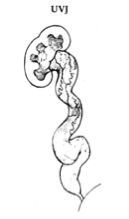Contact Information
What is a megaureter?
A megaureter means “big ureter” and is a descriptive term, not a diagnosis. The two important questions about megaureter are whether there is reflux (backwash) of urine causing the megaureter or whether there is blockage at the ureterovesical junction causing megaureter (Figure 1). If there is reflux, the diagnosis is “refluxing megaureter” or “megaureter from reflux”. If there is obstruction, the diagnosis is “obstructed megaureter” or “primary obstructed megaureter”. If there is neither reflux or obstruction, then the diagnosis is “primary non-obstructed megaureter”. In very rare circumstances, there can be reflux and obstruction and the diagnosis is “refluxing obstructed megaureter”. The two most common types of megaureter by far are the “primary non-obstructed megaureter” and the “refluxing megaureter”.
 Figure 1: Image of a ureterovesical junction obstruction.
Figure 1: Image of a ureterovesical junction obstruction.
What are the symptoms of a megaureter?
Often, megaureters are asymptomatic and discovered on prenatal ultrasound. However, megaureters can also be discovered after a child has a urinary tract infection. Also, occasionally flank pain can be seen or there may be blood in the urine.
How is a megaureter diagnosed?
A megaureter is just a descriptive term meaning large ureter and is diagnosed by ultrasound. Once a megaureter is found, two more tests are generally performed to see if there is reflux or obstruction. A VCUG is performed to look for reflux (see section on VCUG). A lasix renal scan is performed to look for obstruction and how well the kidneys function relative to one another (see section on renal scan).
How are megaureters treated?
Megaureters are treated differently based on their etiology. If there is reflux causing the megaureter, then it is treated with prophylactic antibiotics and occasionally endoscopic or open surgery as appropriate (please see section on vesicoureteral reflux).
If there is obstruction or partial obstruction causing the megaureter at the ureterovesical junction then several factors are considered when recommending treatment. If the kidney with the obstructed or partially obstructed megaureter has decreased function, or there are recurrent urinary tract infections, then a ureteral reimplant (see section on ureteral reimplantation) with removal of the blockage (Figure 1) is recommended. However, if the obstructed or partially obstructed megaureter is not causing symptoms and the kidney is functioning fine, then surgery can often be avoided since the obstruction may resolve over time and the megaureter may go away.
If there is no obstruction and no reflux, the vast majority of these types of megaureters resolve with time and only periodic ultrasounds are performed to assess kidney growth.
Most patients with megaureter will receive prophylactic antibiotics until the megaureter goes away on its own, potty training is completed, or in the cases where surgery is performed, after the surgery is completed.
Why are megaureters treated?
Regardless of the cause of megaureter (reflux or obstruction), megaureters are treated to prevent urinary tract infection and possible kidney damage. Both reflux and obstruction can lead to kidney damage, especially in the setting of urinary tract infections. Prophylactic antibiotics may be given because of the increased risk of urinary tract infection. Surgery may be required as well (see section on surgery above).
What happens after treatment?
Please see the section on vesicoureteral reflux for megaureters caused by reflux.
For megaureters that require surgery, generally prophylactic antibiotics are continued for some time after surgery, and serial ultrasounds are performed to monitor the kidney. The surgery is very successful at relieving the obstruction.
For megaureters that do not have reflux or obstruction, they generally resolve on their own during childhood. Prophylactic antibiotics are often continued until after potty training and periodic ultrasounds are performed to monitor kidney growth and the megaureter. Once the megaureter resolves, there is no need for further follow up or prophylactic antibiotics.
Even if surgery is needed, the vast majority of children with megaureters go on to live normal lives.
Go to the Urology Care Foundation website for more information:
Megaureter